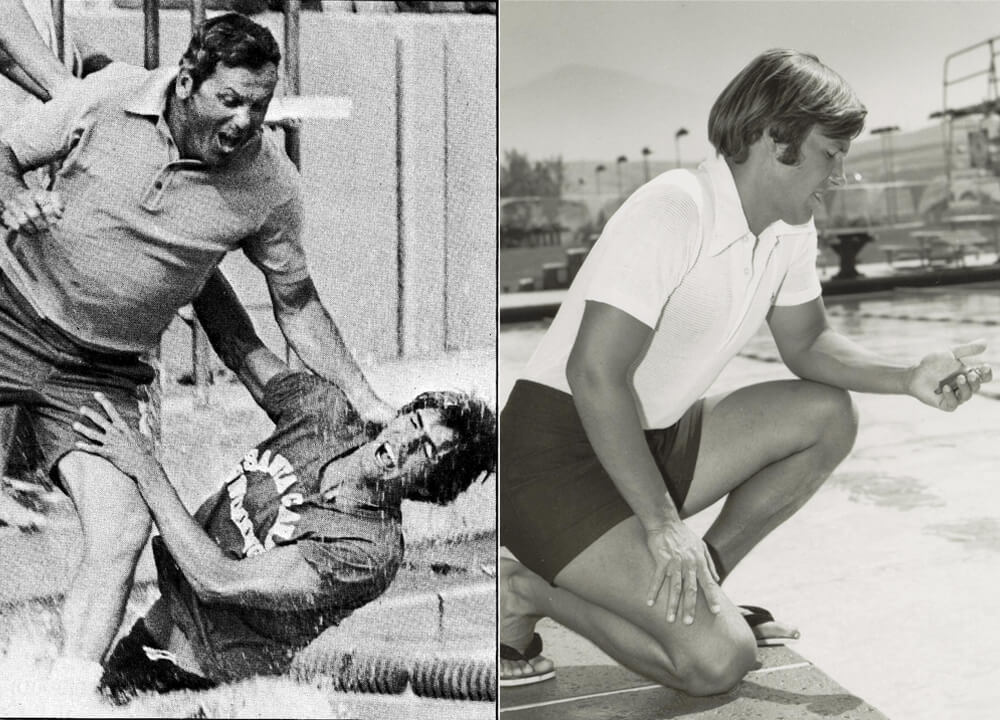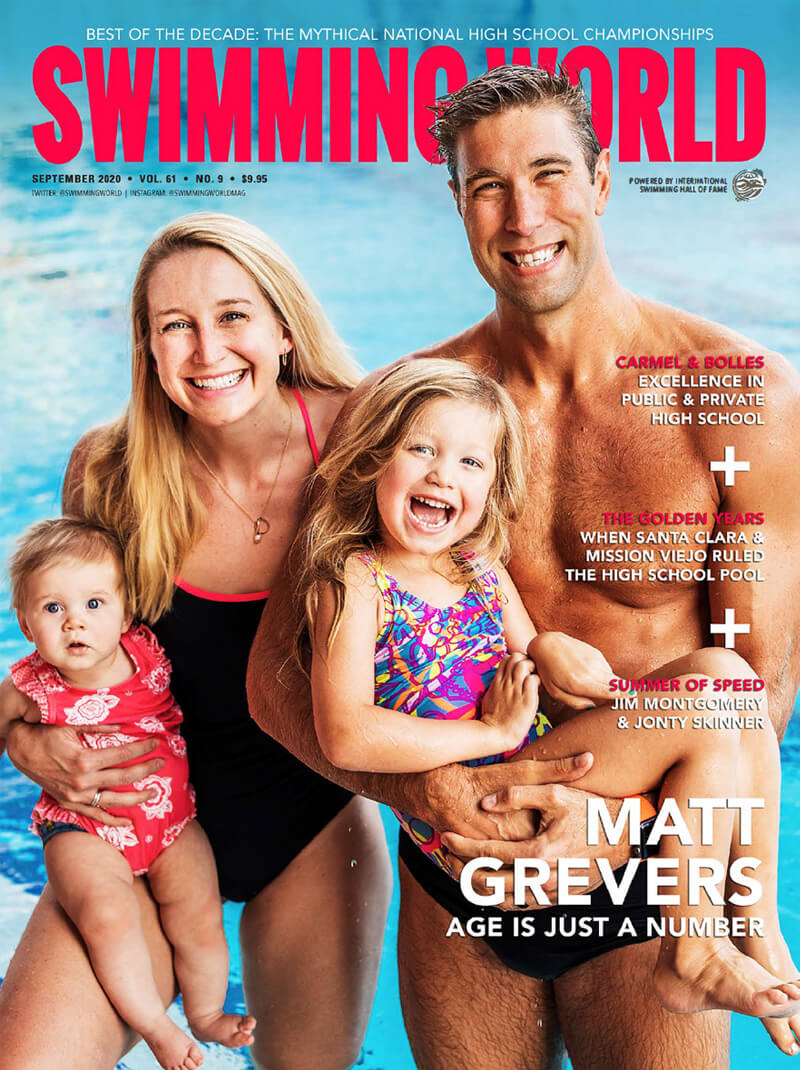Swimming World Presents The Golden Years of High School Swimming: Santa Clara and Mission Viejo

The latest issue of Swimming World Magazine
is now available for download in the Swimming World Vault!
Non-Subscribers Can Download This Issue Here
The Golden Years of High School Swimming: Santa Clara and Mission Viejo
By David Rieder
Public schools Santa Clara and Mission Viejo built high school swimming dynasties from the 1960s through the early 1980s. Not only did they dominate high school swimming, but unlike today, they also produced many of the swimmers from that era who competed in the Olympics.
Of the entire U.S. swim team assembled for the 1964 Olympics in Tokyo, 13 of them had trained in one pool—at Santa Clara High School in northern California under Coach George Haines.
Among Haines’ swimmers at the 1964 Olympics, Don Schollander was the star of the Games, winning gold medals in the 100 and 400 free along with two free relays, and Dick Roth and Donna de Varona earned the inaugural Olympic gold medals in the men’s and women’s 400 IM.
By today’s norms in swimming, a club team of high school-aged swimmers packing an Olympic team would be stunning, but in the 1960s, no college scholarships existed for female swimmers, and there were no professional opportunities beyond college for men. Therefore, the patience and steady development that today’s coaches practice for their young swimmers would have been worthless. Teenage swimmers had to take advantage of their brief window to excel.
GEORGE HAINES: “GREAT COACH, TEACHER AND PERSON”
And to give themselves the best chance at excelling, they turned to Haines, who coached a then-small Santa Clara Swim Club and the Santa Clara High School team. Haines also worked as a high school P.E. instructor, and he had previously also coached the high school lightweight football team.
Schollander moved from his home in Oregon to live with a family in Santa Clara so he could swim for Haines. While living apart from his family, Haines became a father figure for Schollander. On weekends, Schollander would accompany Haines to coaches’ clinics as a demonstrator, and the two bonded during that time. On deck, Haines would quickly adapt and react to fit the needs of his swimmers on a daily basis, and he would vary his workouts to keep his swimmers mentally fresh.
“A lot of coaches just write the workout on the blackboard and then just sit there. He was very, very involved, not only motivating us, but he was always correcting in our stroke technique. I had a tendency to drop my left elbow on freestyle. He would just look at me and touch his elbow,” Schollander said. “Just a great, great coach and a great teacher, great person. That’s what he was.”
MISSION VIEJO: FOLLOWING IN SANTA CLARA’S FOOTSTEPS
In 1972, Mark Schubert first moved from Ohio to California as head coach of the Mission Viejo Nadadores. For years, he had read about Haines and his high school and club teams at Santa Clara, and he aspired to put together a similarly successful program. And indeed, Mission Viejo became the high school swimming mecca of the 1970s and 1980s, just like Santa Clara a decade earlier.
When Swimming World began naming national high school teams of the year in 1971, Santa Clara won four of the first five (boys’ titles), and then, the Mission Viejo girls and boys each won a whopping ten public school titles each between 1977 and 1987.
A year after beginning his tenure with the Nadadores, Schubert started coaching the high school team as well, and Mission Viejo took second at the CIF (California Southern Section) Championships behind the efforts of a freshman named Brian Goodell. The following year, Mission Viejo won the first CIF title in the school’s history. At that meet, Schubert said, “Brian Goodell and Tim Shaw raced head-to-head in the 500, and they were both under the current American record. This wasn’t NCAAs. This was CIF high school kids. Of course, both of those kids ended up making the Olympic team two years later.”
After that, the CIF passed a rule where a coach could not work with his high school athletes out of season, so he had to choose between his club and high school coaching jobs. Although the Mission Viejo High School principal offered him a teaching job so he could continue coaching for the school, Schubert picked club. He recommended a coach named Mike Pelton to take over the high school team, and his stronger swimmers continued to train with the club team during the high school season.
To more about the history of Santa Clara and Mission Viejo,
Check out the full article in September’s issue, available now!
 [PHOTO CREDIT: TAYLOR NATIONS]
[PHOTO CREDIT: TAYLOR NATIONS]
Get Swimming World Magazine and Swimming World Biweekly FREE When You
Become A Member of the International Swimming Hall of Fame
New! 30 Day Membership to ISHOF AND Digital Swimming World Subscription for just $10 a month!
Want more? Get a 1 Year ISHOF Family Membership With Swimming World Print AND Digital Subscription Order Now!
Non-Subscribers can click here to download this issue for only $5.94
Swimming World Magazine September 2020 Issue
FEATURES
010 IN A CLASS OF ITS OWN
by Dan D’Addona
Indiana’s Carmel High School has won the girls’ state swimming and diving championships for 34 straight years, a feat unequaled by any other high school—not only in swimming, but in any other sport.
012 BEST OF THE DECADE (2010-19)
In Swimming World’s first mythical national high school championships to determine the best teams of the last decade, Carmel High School of Indiana won both the girls’ and boys’ competitions.
013 GIRLS’ NATIONAL HIGH SCHOOL CHAMPIONSHIPS MOCK HEAT SHEET: BEST OF THE DECADE (2010-19)
Times compiled by Bob Klapthor
015 BOYS’ NATIONAL HIGH SCHOOL CHAMPIONSHIPS MOCK HEAT SHEET: BEST OF THE DECADE (2010-19)
Times compiled by Bob Klapthor
017 PREP POWER
by Andy Ross
Since Swimming World first began recognizing the top high school teams in the country in 1971, The Bolles School of Jacksonville, Fla., has won 18 national prep school titles—10 boys’, eight girls’. The Bulldogs have also captured 12 combined championships (public and independent schools), with both teams finishing No. 1 six times.
020 THE GOLDEN YEARS OF HIGH SCHOOL SWIMMING
by David Rieder
Public schools Santa Clara and Mission Viejo built high school swimming dynasties from the 1960s through the early 1980s. Not only did they dominate high school swimming, but unlike today, they also produced many of the swimmers from that era who competed in the Olympics.
026 STILL CHASING EXCELLENCE
by John Lohn
Matt Grevers does not need to achieve anything more to stamp himself as an all-time great. But even at 35, there is a desire to accomplish more, and there is no reason to doubt Grevers can come through.
029 SUMMER OF SPEED
by John Lohn
Politics interfered at the 1976 Montreal Olympics, preventing South Africa’s Jonty Skinner from competing head-to-head against the USA’s Jim Montgomery in the men’s 100 freestyle. But that summer, they became the first two swimmers to break the 50-second barrier in the event, with Montgomery clocking 49.99 at Montreal, followed by Skinner with a 49.44 at the AAU National Championships three weeks later.
032 THE TROUBLE WITH SPRINTERS (Part 3): GARY HALL JR.
by Bruce Wigo
The theme of this series of articles has been that sprinters are different from other swimmers—athletes who have historically been considered troublemakers by the establishment, but who have been great for the sport. This month’s featured sprinter is Gary Hall Jr.—one of the greatest in Olympic history…but, perhaps, one of the most maligned and misunderstood.
COACHING
038 SWIMMING TECHNIQUE CONCEPTS: TRUST IN SCIENCE
by Rod Havriluk
Based on the many counterproductive technique elements that are conventional wisdom, it seems logical to ask why there is not a greater acceptance of science in swimming. The purpose of this article is to give swimmers and coaches some very real reasons to trust in science and scientists.
040 SPECIAL SETS: BACK TO BASICS
by Michael J. Stott
While college swimming as we know it faces a roadmap unlike any in recent memory, Coach Eric Skelly of the University of the Cumberlands, Ky. is treating the return to campus and formal practice as business as usual.
043 Q&A WITH COACH SION BRINN
by Michael J. Stott
044 HOW THEY TRAIN TAYLA LOVEMORE
by Michael J. Stott
TRAINING
036 DRYSIDE TRAINING: MORE CORE
by J.R. Rosania
JUNIOR SWIMMER
046 UP & COMERS: GABI BRITO
by Shoshanna Rutemiller
COLUMNS
008 A VOICE FOR THE SPORT
023 DID YOU KNOW? JIM CROW
037 THE OFFICIAL WORD
042 MOMS AT MEETS
047 GUTTERTALK
048 PARTING SHOT
Swimming World is now partnered with the International Swimming Hall of Fame. To find out more, visit us at ishof.org



